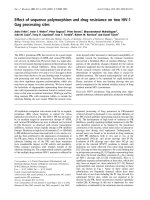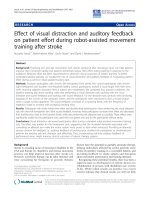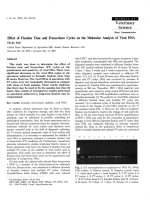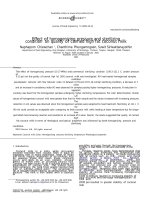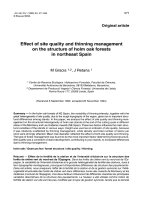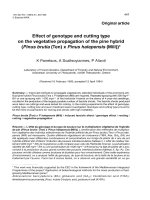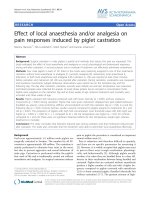Effect of exposure time and elevated temperature on ordinary concrete
Bạn đang xem bản rút gọn của tài liệu. Xem và tải ngay bản đầy đủ của tài liệu tại đây (961.5 KB, 6 trang )
Zhu J and Wu Y (2016) Effect of exposure time
and elevated temperature on ordinary concrete.
Emerging Materials Research,
/>
ice | science
Emerging Materials Research
Research Article
Received 20/04/2016
Accepted 12/12/2016
Keywords: material characterisation/mechanical properties/simulation
ICE Publishing: All rights reserved
Effect of exposure time and elevated
temperature on ordinary concrete
Jianing Zhu PhD
Yaopeng Wu PhD*
School of Civil Engineering, Xi’an University of Architecture and
Technology, Xi’an, People’s Republic of China
School of Civil Engineering, Xi’an University of Architecture and
Technology, Xi’an, People’s Republic of China
The concrete material in structures is likely to be exposed to elevated temperatures during fires. In this paper, an
experimental investigation is carried out to study the effect of different exposure temperatures and times on the
mechanical properties of ordinary concrete. Cylinders with a diameter of 100 mm and a height of 200 mm were used
as concrete specimens, which were tested at the three elevated temperatures of 200, 400 and 600°C for various
times from 1 to 6 h. It was found from the experimental results that the temperature of exposure is the main
contributor to the decrease in the weight and compressive strength of concrete and the exposure time has little
effect. Although the effect of exposure time on weight loss is greater at lower temperatures than that
at higher temperatures, after 3 h of exposure time, the difference becomes negligible. In addition, it was found
that the relative compressive strength of concrete remains unchanged for exposure times exceeding 3 h. The
numerical simulations were conducted using Abaqus. The predicted temperature distributions agree well with the
experimental results.
Notation
c
E
fc
fT
M0
MT
T
T0
t
l
r
1.
heat capacity
exposure time
initial compressive strength of the material at room
temperature
residual compressive strength of the material at elevated
temperature
weight of the specimen at room temperature
weight of the specimen at elevated temperature
exposure temperature
initial temperature
heating-up time
thermal conductivity
density
when it is exposed to different heating treatments with target
temperatures of 250, 500 and 750°C and a holding time of 2·5 h.
Demirel and Keleştemur,5 Akca and Zihnioğlu,6 Tanyildizi7 and
Bastami et al.8 investigated the properties of concrete subjected to
high temperatures with exposure time of 1 h. Moreover,
Kizilkanat et al.,9 Lo Monte and Gambarova10 and Rashad11
investigated the performance of concrete by using a heating
method with an exposure time of 2 h. A standard exposure time of
3 h has been used by many researchers.12–19 In addition, both
heating parameters of the peak temperature and the exposure time
were simultaneously considered. For example, peak temperatures
of 400, 500, 550 and 600°C and exposure times of 0, 1 and 2 h
were used in the experiment by Yang et al.,20 and specimens were
exposed to temperatures of 100 and 200°C for a period of 1, 2 or
3 h by Al-Salloum et al.21
Introduction
Fire is one of the biggest threats to buildings. Since concrete has
become a primary construction material, studies on the material
properties of concrete after exposure to elevated temperatures
have gained great attention. Many studies were carried out on the
influence on the properties of concrete on heating rate, exposure
temperature, exposure time and so on.1,2
3
Ergün et al. assessed the effects of elevated temperatures and
cement dosages on the mechanical properties of concrete. In their
tests, six-test series were conducted with each series consisting of
six different temperatures of 20, 100, 200, 400, 600 and 800°C.
The samples tested at 20°C were considered the baseline
specimens. Once the targeted temperature was reached, this
temperature was maintained for 45 min to achieve a thermal
steady state. Biolzi et al.4 described the consequences of
progressive damage in architectural high-performance concrete
In this��������������������������������������������������������������������������������������������������������������������������������������������������������������������������������������������������������������������������������������������������������������������������������������������������������������������������������������������������������������������������������������������������������������������������������������������������������������������������������������������������������������������������������������������������������������������������������������������������������������������������������������������������������������������������������������������������������������������������������������������������������������������������������������������������������������������������������������������������������������������������������������������������������������������������������������������������������������������������������������������������������������������������������������������������������������������������������������������������������������������������������������������������������������������������������������������������������������������������������������������������������������������������������������������������������������������������������������������������������������������������������������������������������������������������������������������������������������������������������������������������������������������������������������������������������������������������������������������������������������������������������������������������������������������������������������������������������������������������������������������������������������������������������������������������������������������������������������������������������������������������������������������������������������������������������������������������������������������������������������������������������������������������������������������������������������������������������������������������������������������������������������������������������������������������������������������������������������������������������������������������������������������������������������������������������������������������������������������������������������������������������������������������������������������������������������������������������������������������������������������������������������������������������������������������������������������������������������������������������������������������������������������������������������������������������������������������������������������������������������������������������������������������������������������������������������������������������������������������������������������������������������������������������������������������������������������������������������������������������������������������������������������������������������������������������������������������������������������������������������������������������������������������������������������������������������������������������������������������������������������������������������������������������������������������������������������������������������������������������������������������������������������������������������������������������������������������������������������������������������������������������������������������������������������������������������������������������������������������������������������������������������������������������������������������������������������������������������������������������������������������������������������������������������������������������������������������������������������������������������������������������������������������������������������������������������������������������������������������������������������������������������������������������������������������������������������������������������������������������������������������������������������������������������������������������������������������������������������������������������������������������������������������������������������������������������������������������������������������������������������������������������������������������������������������������������������������������������������������������������������������������������������������������������������������������������������������������������������������������������������������������������������������������������������������������������������������������������������������������������������������������������������������������������������������������������������������������������������������������������������������������������������������������������������������������������������������������������������������������������������������������������������������������������������������������������������������������������������������������������������������������������������������������������������������������������������������������������������������������������������������������������������������������������������������������������������������������������������������������������������������������������������������������������������������������������������������������������������������������������������������������������������������������������������������������������������������������������������������������������������������������������������������������������������������������������������������������������������������������������������������������������������������������������������������������������������������������������������������������������������������������������������������������������������������������������������������������������������������������������������������������������������������������������������������������������������������������������������������������������������������������������������������������������������������������������������������������������������������������������������������������������������������������������������������������������������������������������������������������������������������������������������������������������������������������������������������������������������������������������������������������������������������������������������������������������������������������������������������������������������������������������������������������������������������������������������������������������������������������������������������������������������������������������������������������������������������������������������������������������������������������������������������������������������������������������������������������������������������������������������������������������������������������������������������������������������������������������������������������������������������������������������������������������������������������������������������������������������������������������������������������������������������������������������������������������������������������������������������������������������������������������������������������������������������������������������������������������������������������������������������������������������������������������������������������������������������������������������������������������������������������������������������������������������������������������������������������������������������������������������������������������������������������������������������������������������������������������������������������������������������������������������������������������������������������������������������������������������������������������������������������������������������������������������������������������������������������������������������������������������������������������������������������������������������������������������������������������������������������������������������������������������������������������������������������������������������������������������������������������������������������������������������������������������������������������������������������������������������������������������������������������������������������� 102
+5·986 × 102
+5·984 × 102
+5·982 × 102
+5·981 × 102
+5·979 × 102
+5·977 × 102
(b)
(a)
NT11
NT11
+6·000 × 102
+6·000 × 102
+6·000 × 102
+6·000 × 102
+6·000 × 102
+6·000 × 102
+6·000 × 102
+6·000 × 102
+6·000 × 102
+6·000 × 102
+6·000 × 102
+6·000 × 102
+6·000 × 102
+6·000 × 102
+6·000 × 102
+6·000 × 102
+5·999 × 102
+5·999 × 102
+5·999 × 102
+5·999 × 102
+5·999 × 102
+5·998 × 102
+5·998 × 102
+5·998 × 102
+5·998 × 102
+5·998 × 102
(c)
NT11
(d)
NT11
+6·000 × 102
+6·000 × 102
+6·000 × 102
+6·000 × 102
+6·000 × 102
+6·000 × 102
+6·000 × 102
+6·000 × 102
+6·000 × 102
+6·000 × 102
+6·000 × 102
+6·000 × 102
+6·000 × 102
+6·000 × 102
+6·000 × 102
+6·000 × 102
+6·000 × 102
+6·000 × 102
+6·000 × 102
+6·000 × 102
+6·000 × 102
+6·000 × 102
+6·000 × 102
+6·000 × 102
+6·000 × 102
+6·000 × 102
(f)
(e)
Figure 4. Temperature distributions after exposure at 600°C for (a) 1, (b) 2, (c) 3, (d) 4, (e) 5 and (f) 6 h
600°C. As the exposure time is increased from 1 to 3 h, the
weight ratio decreases at each exposure temperature. After over
3 h of exposure time, however, the weight ratio is kept at a
relatively constant value, indicating no further weight loss.
Furthermore, the effect of exposure time on weight loss is greater
at lower heating temperatures (such as 200°C) than that at higher
heating temperatures (such as 600°C).
The results in Figure 5 demonstrate that the weight loss of the
concrete specimen occurs mainly at the early stage of hightemperature exposure and almost no further weight loss occurs
after 3 h of exposure. Therefore, 3 h of exposure time at an
elevated temperature is sufficient in the study of the effect of the
temperature effect on the behaviour of the ordinary concrete.
4
4.2 Compressive strength
Shown in Figure 6 are the relative compressive strengths of concrete
after the specimen was subjected to different exposure temperatures
with different exposure times, in which the data are the average data
from three replicate tests. The relative strength is defined as the ratio
of the residual compressive strength at the elevated temperature to
the initial compressive strength at room temperature. It can be
concluded from Figure 6 that the decrease in the compressive
strength of the specimen results mainly from the exposure
temperature and the exposure time has no significant effect on the
residual strength in the specimen. It is also seen from Figure 6 that
at an exposure temperature of 200°C, the relative compressive
strength of concrete decreases only slightly when compared to the
original strength and is almost independent of the exposure time.
Downloaded by [ Swinburne University] on [11/01/17]. Copyright © ICE Publishing, all rights reserved.
Emerging Materials Research
Effect of exposure time and elevated
temperature on ordinary concrete
Zhu and Wu
1·00
1·10
0·99
200ºC
0·98
400ºC
1·00
600ºC
0·90
0·80
0·96
0·95
fT/fc
MT/M0
0·97
0·94
0·60
0·93
0·92
0·50
0·91
0·40
0·90
1
2
3
4
Exposure time: h
5
0·30
6
Figure 5. Relation of the weight ratio of the specimen with the
exposure time at different exposure temperatures
When the exposure temperature rises to 400 and 600°C, the relative
compressive strength of concrete decreases significantly as the
exposure temperature increases, and at 600°C less than 60% of the
original compressive strength is maintained. At high exposure
temperatures of 400 and 600°C, the relative compressive strength
of concrete slightly decreases as the exposure time is increased
from 1 to 3 h and then is almost independent of exposure time after
3 h. This implies that exposure time exceeding 3 h cannot further
change the relative compressive strength of concrete.
5.
0·70
Conclusions
The influence of the exposure temperature (200, 400, 600°C) and
the exposure time (1–6 h) on the weight loss and the relative
compressive strength of concrete was investigated in this study.
Based on this experimental study and the numerical simulation
using Abaqus, the following conclusions can be made.
■ The decrease in the weight and compressive strength of
concrete results mainly from the exposure temperature, and
effect of the exposure time is insignificant.
■ The effect of the exposure time on weight loss is greater at a
lower exposure temperature (200°C) than that at a higher
temperature (600°C).
■ No further weight loss and decrease in the relative compressive
strength of concrete occur after 3 h of exposure time.
■ Three hours of exposure time is sufficient to reach a stable
state for ordinary concrete at elevated temperatures, which is
further confirmed by numerical simulation results using
Abaqus.
1
2
400ºC
3
4
Exposure time: h
600ºC
5
6
Figure 6. Relation of the compressive strength of the specimen
with the exposure time at different exposure temperatures
Government of China (CXY1432(4)), Opening Funds of State
Key Laboratory of Building Safety and Built Environment
(BSBE2016-2) and Innovation Team of Xi’an University of
Architecture and Technology. The authors are grateful to the
financial support provided by all sponsors.
REFERENCES
1. Ma Q, Guo R, Zhao Z, Lin Z and He K (2015) Mechanical properties of
2.
3.
4.
5.
6.
7.
8.
9.
10.
Acknowledgements
This research was sponsored by the National Natural Science
Foundation of China (51108371), Shaanxi Natural Sciences
Foundation of China (2015JM5164), Key Laboratory of
Education Department of Shaanxi Provincial Government of
China (16JS050), Xi’an Foundation of Shaanxi Provincial
200ºC
11.
12.
concrete at high temperature. Construction and Building Materials
93: 371–383.
Khaliq W and Khan HA (2015) High temperature material properties
of calcium aluminate cement concrete. Construction and Building
Materials 94: 475–487.
Ergün A, Kürklü G, Serhat BM and Mansour MY (2013) The effect of
cement dosage on mechanical properties of concrete exposed to high
temperatures. Fire Safety Journal 55: 160–167.
Biolzi L, Di Luzio G and Labuz JF (2013) Mechanical properties of
photocatalytic white concrete subjected to high temperatures. Cement
and Concrete Composites 39: 73–81.
Demirel B and Keleştemur O (2010) Effect of elevated temperature
on the mechanical properties of concrete produced with finely ground
pumice and silica fume. Fire Safety Journal 45: 385–391.
Akca AH and Zihnioğlu NO (2013) High performance concrete under
elevated temperatures. Construction and Building Materials 44: 17–328.
Tanyildizi H (2013) Variance analysis of crack characteristics of
structural lightweight concrete containing silica fume exposed to high
temperature. Construction and Building Materials 47: 1154–1159.
Bastami M, Baghbadrani M and Aslani F (2014) Performance of
nano-silica modified high strength concrete at elevated temperatures.
Construction and Building Materials 68: 402–408.
Kizilkanat AB, Yüzer N and Kabay N (2013) Thermo-physical
properties of concrete exposed to high temperature. Construction and
Building Materials 45: 157–161.
Lo Monte F and Gambarova PG (2014) Thermo-mechanical behavior
of baritic concrete exposed to high temperature. Cement and Concrete
Composites 53: 305–315.
Rashad AM (2015) An investigation of high-volume fly ash concrete
blended with slag subjected to elevated temperatures. Journal of
Cleaner Production 93: 47–55.
Bingöl AF and Gül R (2009) Residual bond strength between steel
bars and concrete after elevated temperatures. Fire Safety Journal 44:
854–859.
Downloaded by [ Swinburne University] on [11/01/17]. Copyright © ICE Publishing, all rights reserved.
5
Emerging Materials Research
Effect of exposure time and elevated
temperature on ordinary concrete
Zhu and Wu
13. Behnood A and Ghandehari M (2009) Comparison of compressive
18. Uysal M, Yilmaz K and Ipek M (2012) Properties and behavior of self-
14.
15.
16.
17.
and splitting tensile strength of high-strength concrete with and
without polypropylene fibers heated to high temperatures. Fire Safety
Journal 44: 1015–1022.
Chen B, Li CL and Chen LZ (2009) Experimental study of mechanical
properties of normal-strength concrete exposed to high temperatures at
an early age. Fire Safety Journal 44(7): 997–1002.
Cülfik MS and Özturan T (2010) Mechanical properties of normal and
high strength concretes subjected to high temperatures and using
image analysis to detect bond deteriorations. Construction and
Building Materials 24: 1486–1493.
Uysal M (2012) Self-compacting concrete incorporating filler
additives: performance at high temperatures. Construction and
Building Materials 26: 701–706.
Ding Y, Azevedo C, Aguiar JB and Jalali S (2012) Study on residual
behaviour and flexural toughness of fibre cocktail reinforced self
compacting high performance concrete after exposure to high
temperature. Construction and Building Materials 26: 21–31.
19.
20.
21.
22.
compacting concrete produced with GBFS and FA additives subjected
to high temperatures. Construction and Building Materials 28:
321–326.
Uysal M and Tanyildizi H (2012) Estimation of compressive
strength of self compacting concrete containing polypropylene
fiber and mineral additives exposed to high temperature using
artificial neural network. Construction and Building Materials 27(1):
404–414.
Yang H, Lin Y, Hsiao C and Liu JY (2009) Evaluating residual
compressive strength of concrete at elevated temperatures using
ultrasonic pulse velocity. Fire Safety Journal 44: 121–130.
Al-Salloum YA, Elsanadedy HM and Abadel AA (2011) Behavior of
FRP-confined concrete after high temperature exposure. Construction
and Building Materials 25: 838–850.
Rong JM, Lu JW, Yao Y, Liu JY et al. (2002) GB/T 50081-2002:
Standard for test method of mechanical properties on ordinary
concrete. China Academy of Building Research, Beijing, China.
How can you contribute?
To discuss this paper, please submit up to 500 words to the
journal office at Your contribution will be
forwarded to the author(s) for a reply and, if considered
appropriate by the editor-in-chief, it will be published as a
discussion in a future issue of the journal.
ICE Science journals rely entirely on contributions from
the field of materials science and engineering. Information
about how to submit your paper online is available at
www.icevirtuallibrary.com/page/authors, where you will also
find detailed author guidelines.
6
Downloaded by [ Swinburne University] on [11/01/17]. Copyright © ICE Publishing, all rights reserved.
